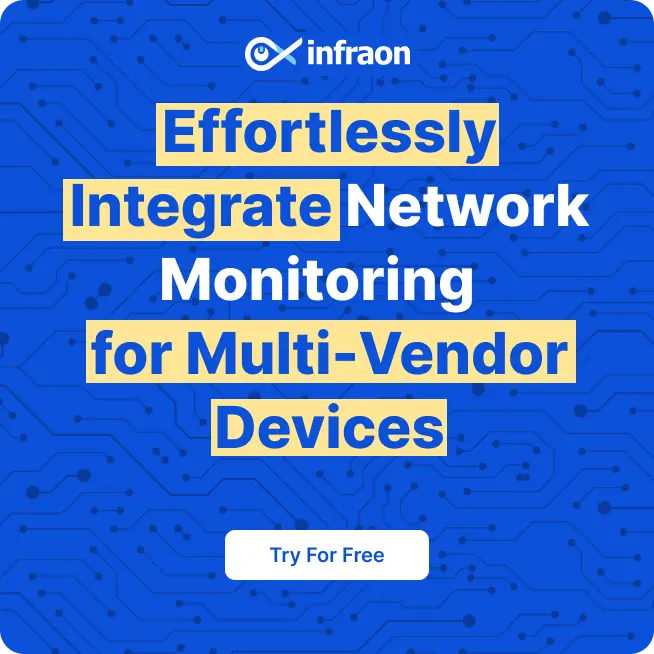Networks generate enormous volumes of data every second. Network monitoring tools determine how that data is collected and analyzed defines the stability of IT operations. Two major frameworks dominate network observability today: SNMP-based and API-based monitoring. Both gather metrics, track uptime, and surface alerts, but their approaches differ in architecture, scalability, and integration depth.
How Does SNMP-Based Visibility Work?
SNMP monitoring tools have shaped enterprise network management for decades. The Simple Network Management Protocol (SNMP) standardizes how routers, switches, and servers expose operational data through structured MIB objects. A centralized monitoring server periodically polls devices using GET or WALK commands, retrieving status values such as bandwidth utilization, interface errors, and link availability.
The mechanism remains fundamental to most network monitoring tools deployed today. Even as automation and virtualization reshape IT, SNMP remains a core telemetry channel due to its lightweight design and backward compatibility.
Why SNMP Still Matters
- Device universality across vendors, models, and firmware generations
- Minimal configuration effort (most hardware already includes SNMP agent)
- Reliable, low-overhead metric polling suitable for large infrastructures
- Direct integration with topology mapping and network discovery
- Real-time status tracking for availability dashboards and alert systems
SNMP’s simplicity, however, introduces limitations in adaptability and security. The polling model can delay data freshness, especially in high-density environments where hundreds of devices respond in cycles. Encrypted versions like SNMPv3 mitigate risk, yet command granularity remains constrained compared to API-driven frameworks.
The Evolution toward API-Based Monitoring
API monitoring tools represent a modern shift from protocol-driven polling to data-driven integration. Instead of querying static MIB objects, APIs expose dynamic endpoints that deliver context-rich data in JSON or XML. It enables real-time telemetry and actionable automation within broader DevOps and ITOps ecosystems.
APIs align perfectly with hybrid architectures that span on-premises hardware, virtual machines, and multi-cloud environments. Modern network monitoring tools empower software-defined visibility, allowing tools like Infraon NMS to fetch live configuration data, event logs, and performance metrics directly from vendor controllers or orchestration platforms.

Advantages of API Monitoring Tools
- Continuous, event-based data flow that reduces latency
- Unified access to physical, virtual, and cloud-native assets
- Secure authentication models such as OAuth 2.0 and token exchange
- Fine-grained automation through POST, PUT, or DELETE requests
- Broader integration across CI/CD pipelines and ITSM systems
The shift from SNMP to API aligns with an era where programmability defines resilience. By consuming endpoints rather than polling counters, APIs unlock scalability and richer data fidelity across large environments.
Data Models and Workflows: SNMP-Based vs. API-Based
| Aspect | SNMP-Based Tools | API-Based Tools |
| Data Flow | Polling at fixed intervals | Event-driven or on-demand |
| Format | MIB OIDs, numeric counters | JSON/XML structured payloads |
| Integration | Traditional NMS and CLI-based tools | Modern analytics and automation stacks |
| Latency | Higher due to polling cycles | Near real-time |
| Security | Community strings or SNMPv3 credentials | Token-based, encrypted sessions |
Enterprises running mixed infrastructure often deploy both SNMP and API channels together. SNMP continues to monitor routers, switches, and access points, while APIs deliver deeper insight into virtualized environments and application layers.

Where SNMP Protocol Monitoring Fits Today
SNMP protocol monitoring still serves as the backbone for availability tracking. It remains ideal for collecting metrics from embedded network devices where APIs are unavailable. Many industrial routers, legacy firewalls, and IoT gateways depend exclusively on SNMP due to limited computational capacity.
With network monitoring solutions expanding into predictive analytics, SNMP data continues to provide historical baselines crucial for performance trend analysis. Administrators rely on this telemetry to correlate throughput patterns, identify threshold violations, and automate escalation workflows.
However, enterprises pursuing higher observability maturity are complementing SNMP with REST or gRPC-based interfaces to achieve richer context.
When to Choose API Monitoring Tools
API integrations transform networks into programmable systems. They connect directly with management platforms, controllers, and service orchestrators, enabling faster response and adaptive automation.
Use cases where API monitoring tools outperform include:
- Cloud-native workloads with rapid scaling requirements
- Dynamic SD-WAN or NFV environments requiring automated reconfiguration
- Integration with ITSM modules for instant incident correlation
- Real-time SLA tracking for distributed user experiences
APIs let administrators interact with infrastructure through the same interfaces developers use for applications. The unified data layer reduces silos, enabling continuous monitoring pipelines across operations and development.
Related Blog: Best Network Monitoring Software and Tools in 2025
How Hybrid Monitoring Delivers Best Results
A combined strategy bridges the reliability of SNMP with the flexibility of APIs. Many enterprises integrate both within platforms like Infraon NMS, which supports dual-mode communication for diverse assets.
- SNMP ensures persistent uptime metrics and device reachability
- APIs deliver advanced analytics and event correlation
- Central dashboards unify both data sources for complete visibility
- Predictive engines leverage historical SNMP data alongside API telemetry
Blending both paradigms empowers organizations to evolve toward a more adaptive monitoring model without abandoning proven architectures.
Building a Future-Ready Monitoring Architecture
Modern IT operations teams need network monitoring tools that deliver visibility scaling with infrastructure complexity. SNMP ensures reliability in foundational networking, while APIs enable agility and real-time insight. The balance between them depends on factors like device capability, compliance policies, and desired automation levels.
For example, service providers running large MPLS backbones may still depend on SNMP polling for interface health, whereas SaaS platforms favor APIs for instant resource metrics and SLA enforcement. Choosing the right balance ensures operational continuity and smooth evolution toward autonomous infrastructure.

Conclusion
SNMP-based and API-based network monitoring tools share the same objective: seamless visibility. Their coexistence represents an operational continuum, from legacy hardware oversight to intelligent, event-driven analytics. The decision depends on architecture maturity, integration scope, and automation goals.
Enterprises modernizing their observability stack often deploy unified suites that support both standards under one interface. That way, teams maintain continuity while transitioning toward predictive, AI-driven operations.
Strengthen Network Visibility with Infraon NMS
Infraon NMS unifies SNMP monitoring tools and API monitoring tools under a single platform. It gives enterprises real-time visibility across devices, interfaces, and services through a flexible, scalable monitoring architecture.
Its capabilities cover network discovery, fault detection, performance analytics, and automation while supporting multi-vendor environments. The platform integrates SNMP protocol monitoring for legacy and embedded devices along with API integrations for controllers, SD-WAN nodes, and cloud systems.
For inquiries or expert guidance on Infraon IMS, contact marketing@infraon.io.
FAQs
1. What is the primary difference between SNMP and API monitoring?
SNMP uses a polling-based model to collect metrics from network devices, while API-based tools use event-driven, programmatic interfaces for real-time data exchange.
2. Can both approaches operate together?
Yes. Many hybrid network monitoring solutions integrate SNMP and API frameworks to cover both legacy and modern systems under one dashboard.
3. Why is SNMP protocol monitoring still relevant?
It remains crucial for devices lacking APIs, such as switches, routers, and industrial hardware that rely on standardized SNMP agents for uptime data.
4. What are the advantages of API monitoring tools?
They deliver faster updates, integrate smoothly with automation workflows, and provide richer insights across hybrid infrastructures.
5. How does Infraon enhance network observability?
Infraon NMS and Infraon IMS merge SNMP and API-based telemetry to provide comprehensive, real-time visibility into network health and service availability.


















